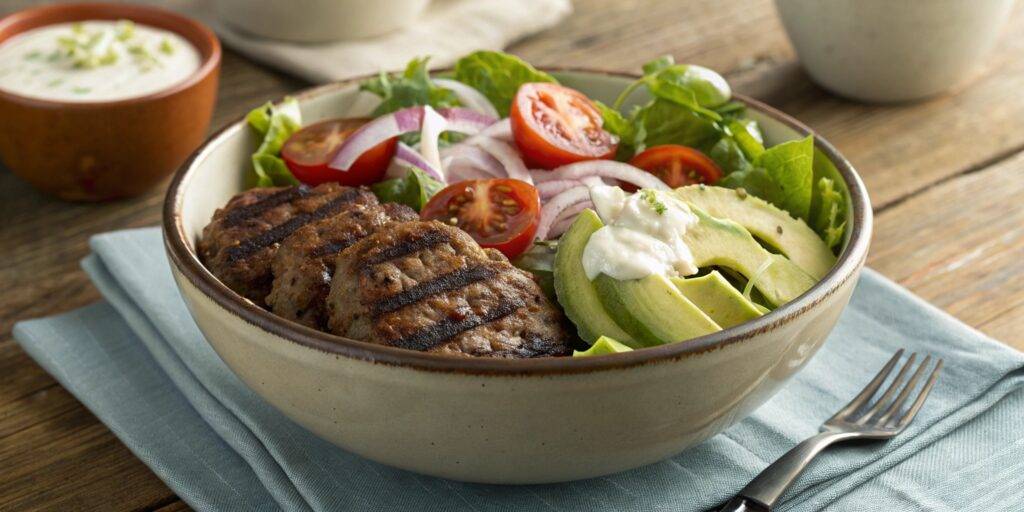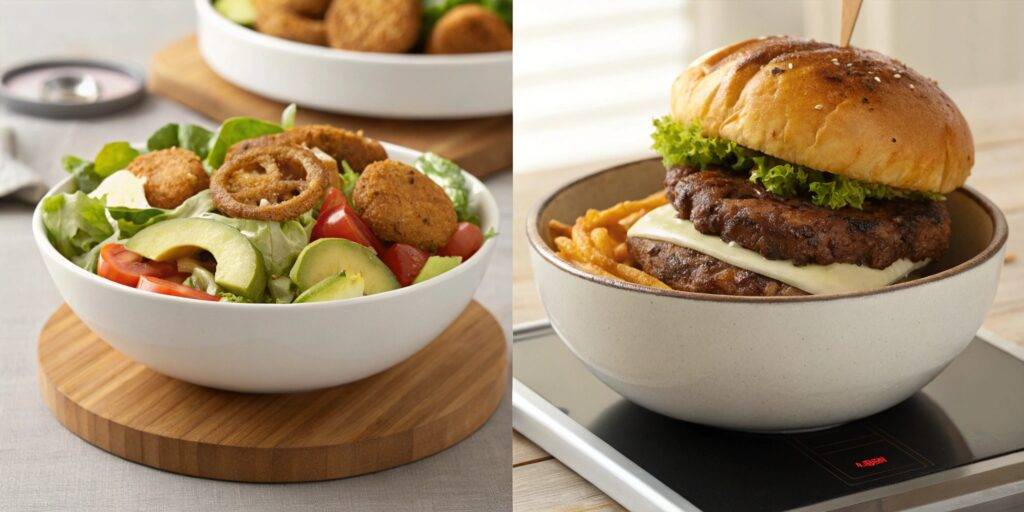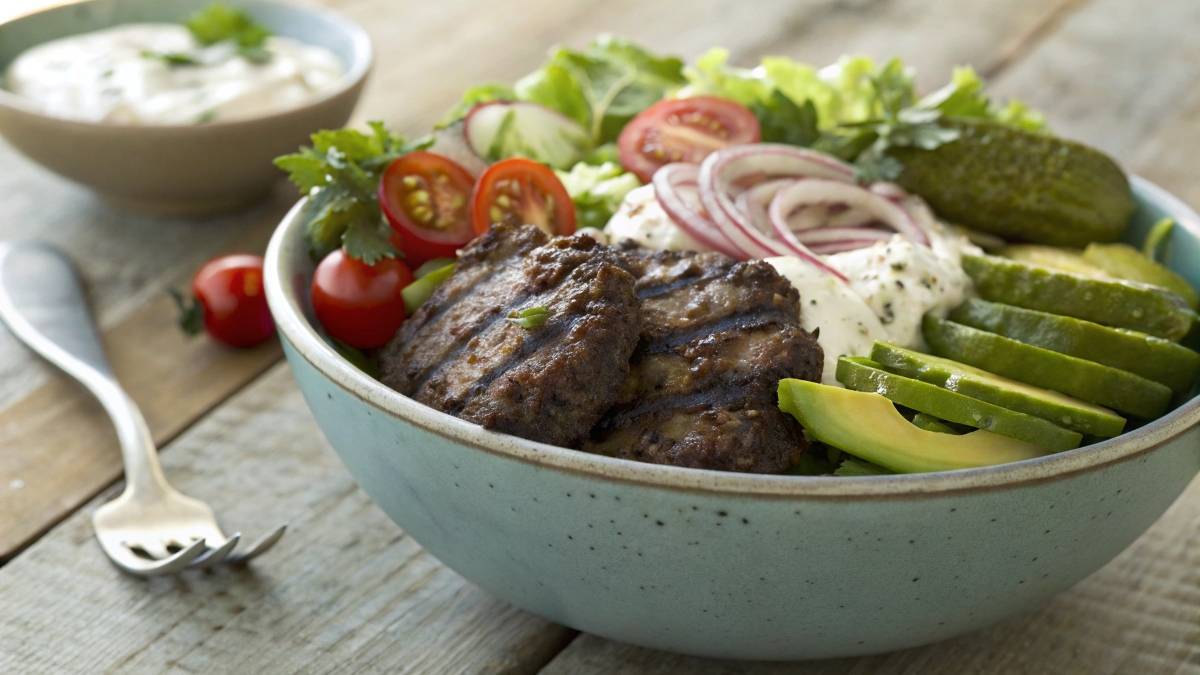Have you ever wondered how many calories are in a burger bowl? With the increasing popularity of low-carb and high-protein meals, burger bowls have undoubtedly emerged as a favorite alternative to traditional burgers. Whether you are tracking calories, striving to eat healthier, or simply curious about your meal’s nutrition, this guide will thoroughly break down the calorie content of a burger bowl, ingredient by ingredient. 🍔🥗
What Is a Burger Bowl?

A burger bowl is essentially a deconstructed burger served without a bun. Instead, the ingredients—such as seasoned ground beef, fresh vegetables, and flavorful toppings—are arranged in a bowl, making it a healthier and more customizable alternative. Notably, this version is especially popular among low-carb, keto, and calorie-conscious eaters.
Why Choose a Burger Bowl Over a Traditional Burger?
- Lower in carbs: Removing the bun significantly reduces carbohydrate intake.
- More control over ingredients: You can customize it to be high in protein, low in fat, or packed with fresh veggies.
- Better for portion control: Without a bun, you focus more on nutrient-dense ingredients.
Understanding Caloric Content in a Burger Bowl
The calorie count of a burger bowl largely depends on the ingredients used. While some variations contain fewer than 400 calories, others may easily exceed 1,000 calories.
Calories in Different Types of Burger Meat
| Meat Type | Calories per 4 oz (113g) |
|---|---|
| 80/20 Ground Beef | 290 kcal |
| 90/10 Lean Ground Beef | 200 kcal |
| Ground Turkey | 170 kcal |
| Grilled Chicken Breast | 120 kcal |
| Plant-Based Patty | 180-250 kcal |
Calories in Burger Bowl Toppings
Toppings can either keep the calorie count low or significantly increase it. Here’s a quick breakdown of common toppings:
- Cheese (1 slice): 70–110 kcal 🧀
- Avocado (¼ medium): 60 kcal 🥑
- Grilled Onions (¼ cup): 30 kcal
- Bacon (1 slice): 43 kcal
- Lettuce, Tomato, Pickles: Under 10 kcal per serving 🥗
- Ranch Dressing (2 tbsp): 145 kcal
Low-Calorie and High-Calorie Burger Bowl Additions
If you are closely watching your calorie intake, it is best to focus on lean proteins, fresh vegetables, and lighter dressings. Meanwhile, some high-calorie additions include:
- Healthier options: Grilled chicken, mushrooms, spinach, and mustard.
- Higher calorie choices: Heavy cheese, mayo-based sauces, and fried onions.
How Portion Size Affects Calories
Even when using healthy ingredients, portion sizes play a crucial role in calorie intake. For instance, a burger bowl with 4 oz of beef, cheese, and avocado may contain around 500 calories. However, doubling portions can quickly push the calorie count beyond 1,000 calories! ⚖️
The Role of Cooking Methods in Calorie Differences
Cooking methods also impact the overall calorie content. Here’s a closer look at how different techniques affect calorie levels:
- Grilling: Retains flavor without adding extra fat. ✅
- Baking: A great alternative with minimal oil usage. ✅
- Frying: Significantly increases calories due to excess oil absorption. ❌
Calorie Comparison: Burger Bowl vs. Traditional Burger
| Meal | Calories |
|---|---|
| Classic Cheeseburger with Bun | 750-900 kcal |
| Burger Bowl (Lean Beef + Veggies + Light Dressing) | 400-600 kcal |
Final Thoughts on Burger Bowl Calories
So, how many calories are in a burger bowl? Ultimately, the total depends on the ingredients, portion sizes, and cooking methods used. Nevertheless, a well-balanced burger bowl can be a nutritious, satisfying, and delicious meal that seamlessly fits into any diet plan! 🍔🥗
Looking for a tasty burger bowl recipe? Be sure to check out our guide for the perfect combination of flavors and essential nutrients!
How to Calculate Calories in a Homemade Burger Bowl
Creating a homemade burger bowl not only allows you to enjoy a delicious meal but also gives you full control over your ingredients. However, how do you calculate the calories? The key lies in carefully measuring your portions and utilizing nutrition-tracking tools to ensure an accurate calorie count.
Using a Nutrition Calculator for Accuracy
Thankfully, apps like MyFitnessPal, Cronometer, or Fitbit make it easy to log each ingredient and determine the total calories. To do this effectively, follow these simple steps:
- Weigh each ingredient: Always use a kitchen scale for maximum precision. ⚖️
- Check nutrition labels: Pay close attention to serving sizes and portion measurements.
- Use an online calorie calculator: Enter each ingredient to generate an accurate total.
Calories in Popular Fast-Food Burger Bowls
If you prefer eating out, you should always be aware of hidden calories. Many restaurant burger bowls contain calorie-dense dressings, extra cheese, and rich sauces that quickly increase the overall count. Here’s a comparison of popular options:
| Restaurant | Burger Bowl Calories |
|---|---|
| Five Guys Burger Bowl | 800–1,100 kcal |
| Shake Shack Burger Bowl | 650–900 kcal |
| In-N-Out Protein Style | 400–500 kcal |
What Is the Healthiest Way to Have a Burger Bowl?
To keep your burger bowl both nutritious and balanced, you should focus on incorporating lean proteins, fiber-rich vegetables, and healthy fats. Let’s break it down into simple choices:
Best Lean Protein Options for a Low-Calorie Burger Bowl
Since protein is the centerpiece of a burger bowl, selecting the right option can help lower calories while maintaining great taste. Here are some of the best choices:
- Grilled chicken breast: 120 kcal per 4 oz ✅
- Extra-lean ground turkey: 170 kcal per 4 oz ✅
- Plant-based patties: 180-250 kcal per patty ✅
- 80/20 ground beef: 290 kcal per 4 oz ❌ (higher fat content)
Low-Carb and Keto-Friendly Burger Bowl Options
For those following a low-carb or keto-friendly diet, it is best to swap starchy toppings for high-fiber, nutrient-dense alternatives. Here are some smart substitutions:
- Choose a lettuce base instead of rice or potatoes. 🥬
- Replace mayo with Greek yogurt-based sauces for a creamy but healthier option. 🥣
- Add avocado for healthy fats while avoiding unnecessary carbs. 🥑
High-Protein Burger Bowl Variations
If you want to increase your protein intake without adding too many extra calories, consider these simple additions:
- Egg whites: 17 kcal per egg white 🍳
- Cottage cheese: 90 kcal per ½ cup 🥣
- Tofu crumbles: 80 kcal per ½ cup 🥢
Smart Topping Choices for Lower Calories
While some toppings can keep your burger bowl light and nutritious, others can double the calorie count. Let’s explore the best options:
What Are Low-Sodium Burger Toppings?
Reducing sodium intake is not only beneficial for heart health but also helps minimize bloating. To make healthier choices, opt for these low-sodium toppings:
- Fresh avocado: Naturally low in sodium and packed with nutrients. 🥑
- Grilled onions: Enhances flavor without excess salt. 🧅
- Homemade salsa: A flavorful alternative to ketchup with far less sodium. 🍅
Dressing & Sauce Choices: Caloric Breakdown
Dressings and sauces can dramatically change the calorie count of your burger bowl. Here’s how some popular options compare:
| Condiment | Calories (per 2 tbsp) |
|---|---|
| Ranch Dressing | 145 kcal |
| Mayo | 180 kcal |
| Mustard | 5 kcal |
| Hot Sauce | 0-10 kcal |
Final Thoughts on Customizing Your Burger Bowl
In the end, building a burger bowl with lean proteins, fresh vegetables, and thoughtful toppings allows you to keep your meal under 500 calories while still enjoying incredible flavor! 🎉
Are you ready to create your own delicious burger bowl? If so, be sure to check out our amazing burger bowl recipe to get started! 🍽️
Does Five Guys Do a Burger Bowl?
If you’re a fan of Five Guys, you may be wondering: Does Five Guys offer a burger bowl? The good news is, yes! Instead of serving their burgers with a bun, Five Guys allows you to order a “bowl style” version, which consists of a bed of lettuce topped with all your favorite burger ingredients. 🍔🥗
How Many Calories in a Five Guys Burger Bowl?
Unlike other fast-food chains that offer pre-made burger bowls, Five Guys lets you completely customize yours. However, because their portions tend to be larger than average, the calorie count can quickly add up.
| Five Guys Burger Bowl | Calories |
|---|---|
| Single Patty (Beef) | 302 kcal |
| Double Patty (Beef) | 604 kcal |
| Cheese (1 slice) | 70 kcal |
| Grilled Onions | 40 kcal |
| Avocado | 60 kcal |
| Mayo | 200 kcal |
Customizing a Five Guys Burger Bowl for Fewer Calories
If you want to enjoy a Five Guys burger bowl without consuming excessive calories, consider these smart swaps:
- Opt for a single patty instead of a double – this instantly saves over 300 calories! 🍔
- Choose mustard or hot sauce instead of mayo – you’ll cut 200 calories right away. 🌶️
- Load up on fresh veggies like tomatoes, grilled mushrooms, and lettuce for flavor without unnecessary calories. 🥬🍄
Caloric Comparison: Homemade vs. Restaurant Burger Bowls
Generally, restaurant burger bowls tend to be higher in calories due to larger portions and calorie-dense toppings. Here’s how Five Guys compares to other options:
| Burger Bowl Type | Calories |
|---|---|
| Homemade Burger Bowl (Lean Beef, Light Toppings) | 400–600 kcal |
| Five Guys Burger Bowl | 800–1,100 kcal |
| Shake Shack Burger Bowl | 650–900 kcal |
Tips for Eating a Burger Bowl at a Restaurant
If you’re dining out and trying to keep your meal under 600 calories, consider these tips:
- Skip extra cheese: One slice adds 70-100 kcal. ❌🧀
- Order dressing on the side: This way, you control how much you use. 🥗
- Pick grilled over fried toppings: Grilled onions and mushrooms have fewer calories than crispy versions. 🔥
Fast-Food Chains That Offer Low-Calorie Burger Bowls
Besides Five Guys, several other fast-food chains also provide burger bowl options:
- In-N-Out “Protein Style”: A burger wrapped in lettuce instead of a bun (400-500 kcal). 🍃
- Shake Shack “Lettuce Wrap”: A deconstructed burger with customizable toppings. 🥗
- Chipotle “Burger Bowl”: A limited-edition option featuring lean protein choices. 🌯
Are Burger Bowls Good for Weight Loss?
Absolutely! A well-made burger bowl can fit perfectly into any weight loss meal plan, as long as you choose ingredients wisely.
How to Modify a Burger Bowl for Fat Loss
To keep calories low while still enjoying a satisfying meal, follow these simple modifications:
- Use lean protein: Opt for turkey or grilled chicken instead of fatty beef. 🐓
- Watch your toppings: Skip mayo and go for mustard, salsa, or hot sauce. 🌶️
- Fill up on fiber: Load your bowl with greens, bell peppers, and cucumbers. 🥒
The Best Macronutrient Ratios for a Healthy Burger Bowl
A well-balanced burger bowl should include the right mix of protein, fat, and carbohydrates. Here’s an ideal macronutrient breakdown:
- 40% Protein: Supports muscle recovery and keeps you full. 🍗
- 30% Healthy Fats: Includes avocado, nuts, and olive oil for essential nutrients. 🥑
- 30% Carbs: Primarily from fiber-rich vegetables or a small portion of grains. 🌽
The Impact of Portion Control on Calories

Even healthy ingredients can lead to excessive calorie intake if portions are too large. Stick to these recommended serving sizes:
- Protein: 4 oz (about the size of your palm) 🍖
- Cheese: 1 slice or 1 oz 🧀
- Healthy fats: ¼ avocado or 1 tsp olive oil 🥑
Final Thoughts on Restaurant Burger Bowls
So, are restaurant burger bowls a healthy choice? Yes, but it all depends on how you customize them! By choosing lean proteins, fresh vegetables, and lighter dressings, you can enjoy a burger bowl while staying within your calorie goals. 🍔🥗
Are you ready to make a healthier version at home? Try our homemade burger bowl recipe for a delicious, low-calorie meal!
Common Mistakes That Add Unwanted Calories
Even though burger bowls are a great alternative to traditional burgers, many people unknowingly add extra calories without realizing it. To help you avoid these pitfalls, here are the most common mistakes:
- Using high-calorie dressings: Ranch, mayo, and creamy sauces can quickly turn a healthy bowl into a 1,000+ calorie meal. Instead, opt for low-calorie dressing alternatives. 🥗
- Adding too much cheese: While cheese enhances flavor, multiple slices can significantly raise calorie intake. Therefore, it’s best to stick to one slice or try nutritional yeast as a substitute. 🧀
- Overloading on fatty meats: Choosing an 80/20 beef patty instead of a leaner protein can add 100+ extra calories. For a healthier option, consider lean protein alternatives. 🍗
Hidden High-Calorie Ingredients to Avoid
Some ingredients may seem harmless, yet they can drastically increase your calorie count. To maintain a balanced meal, be mindful of the following:
- Fried onions: Adds an extra 100+ calories per serving.
- Croutons or crispy toppings: Often loaded with hidden fats and carbs. ❌
- Sweet sauces (BBQ, teriyaki): High in sugar, adding empty calories. 🍯
The Best Meal Prep Strategies for Burger Bowls
If you want to enjoy homemade burger bowls throughout the week, meal prepping is the key! 🥗 Here’s how you can simplify the process:
- Pre-cook your protein: Grill or bake several portions of lean beef, turkey, or chicken ahead of time. 🍖
- Chop veggies in advance: Store fresh lettuce, tomatoes, onions, and cucumbers in airtight containers for easy access. 🥬
- Portion out toppings: Pre-measure cheese, avocado, and sauces to prevent overeating. ⚖️
Frequently Asked Questions
Are Burger Bowls Healthier Than Burgers?
Yes! A burger bowl is generally healthier than a traditional burger because it eliminates the bun and allows for better portion control. Additionally, you can load up on extra veggies for fiber and choose lean proteins to reduce fat intake.
What’s the Best Way to Lower Burger Bowl Calories?
To reduce calories while keeping your meal flavorful, follow these practical tips:
- Use low-calorie toppings like grilled onions and mustard. 🌶️
- Swap fatty meats for lean protein options such as turkey or chicken. 🐔
- Skip mayo and opt for Greek yogurt-based dressings for a creamy yet healthier choice. 🥗
Can You Eat a Burger Bowl on a Low-Carb Diet?
Absolutely! A low-carb burger bowl is perfect for keto and paleo diets. To stay on track, simply avoid starchy toppings like croutons and instead choose high-fat, low-carb additions such as avocado and olive oil. 🥑
How Many Calories Should a Healthy Burger Bowl Have?
Ideally, a balanced burger bowl should contain between 400–600 calories. If your bowl exceeds 800 calories, it likely contains high-calorie add-ons such as mayo, bacon, or heavy cheeses.
What’s the Best Way to Add More Protein Without Extra Calories?
If you’re looking to increase protein intake without excess fat, consider these healthy options:
- Egg whites: Only 17 kcal per egg white! 🍳
- Lean turkey or chicken: High in protein, yet low in calories. 🦃
- Cottage cheese: Low in fat while being packed with protein. 🥣
Final Thoughts: Making the Best Burger Bowl for You
So, how many calories are in a burger bowl? The answer ultimately depends on your choices. Whether you’re making one at home or ordering at a restaurant, you can easily enjoy a healthy and delicious burger bowl by selecting lean proteins, fresh veggies, and mindful toppings. 🍔🥗
Need some inspiration? Check out our delicious burger bowl recipe and start creating your own nutritious and satisfying meals today! 🚀

